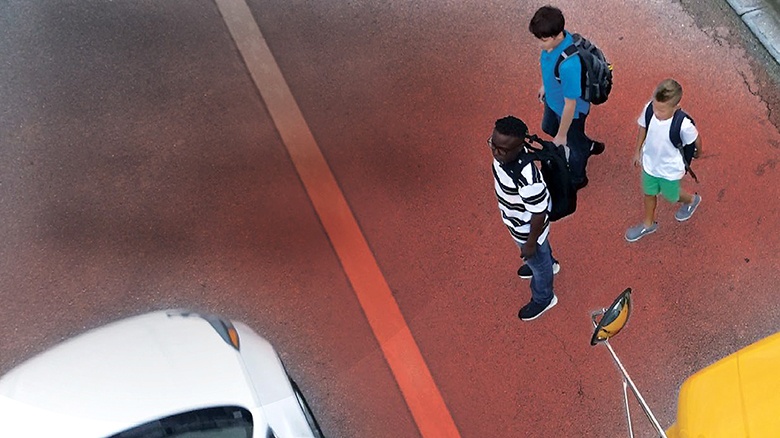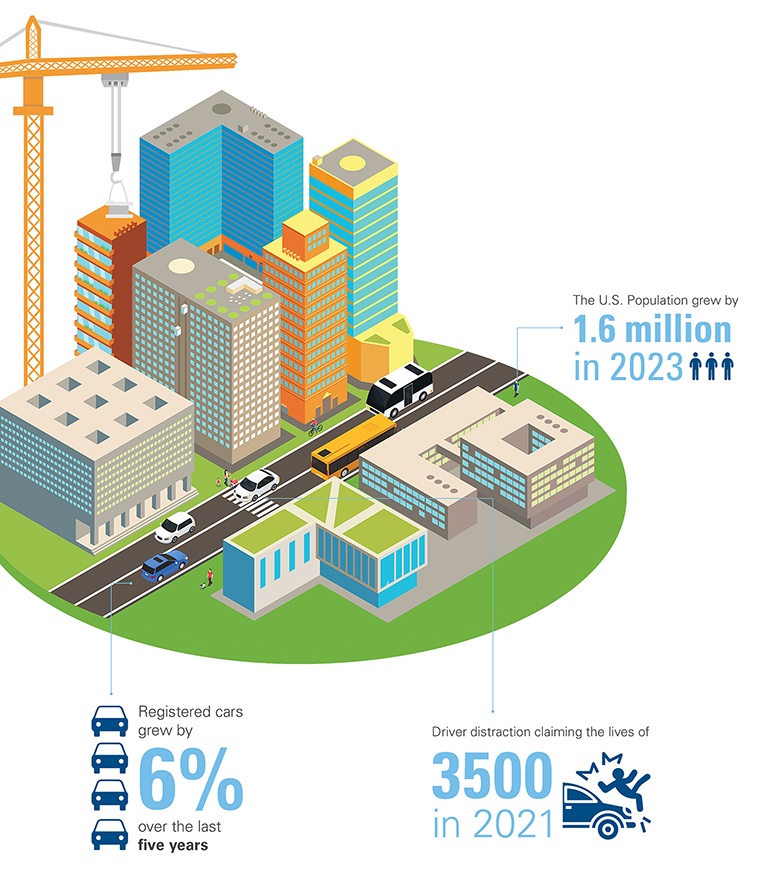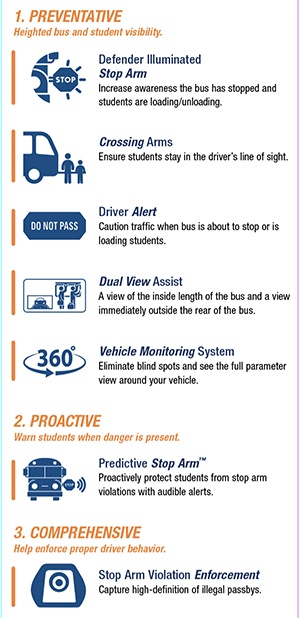
The ninth annual National Association of State Directors of Pupil Transportation Services (NASDPTS) survey of national illegal school bus passes found more than 95,000 motorists ran school bus stop arms in one day in the 2023 school year.
The previous year’s survey reported 83,944 passing incidents.
That’s a shocking increase, especially when you consider the spotlight on this issue and the brainpower and development that has gone into trying to reduce risk to students outside the bus.
Given that illegal school bus passbys are increasing and have reached an epidemic level in the U.S., it’s safe to assume a significant number of school bus related injuries every year can be attributed to the area outside the bus known as the Danger Zone.
When we talk about issues and risks around the bus – the root cause is human attention, which is inherently limited.
Turning the Danger Zone into a Safety Zone
Safety equipment such as stop arms, amber and red warning lights, a roof mounted strobe light, and driver LED alert signage was designed to alert motorists to stop for the school bus. Safety standards, legislation, policies, driver training and bus safety education continue to be introduced to protect children in this sensitive area. Yet the bus still remarkably remains ‘invisible.’
Our cities and towns are growing. The U.S. Population grew by 1.6 million in 2023. The number of registered cars on our streets grew by 6 percent over the last five years. And driver distraction at all-time-high numbers, claiming over 3,500 lives in 2021. We have access to cost-effective technology to help us thrive amongst all this change and yet as it relates to safety school bus safety, what we’ve done to date is still not enough: children are still at risk

The Stop for School Buses Act
Following a 2018 fatal accident in which three students were killed and another injured after a motorist failed to stop for a school bus, the National School Transportation Association (NSTA) initiated a push for legislation to protect students outside the bus.
The resulting Stop for School Buses Act was passed as a provision of the Infrastructure Investment and Jobs Act signed by President Joe Biden. As part of this Bill, the National Highway Traffic Safety Administration (NHTSA) has been mandated to research education, advocacy and technology that will enhance student safety around the bus. Directly called out in the mandate are technologies such as radar and proactive notification systems.
Changing Our Approach by Adding Intelligence to the Bus
We’ve been trying to tackle this critical issue as an industry for years. Stop arms, crossing gates, and cameras have each helped reduce the number of fatal injuries and improve safety, but to get the number of children killed in transportation-related crashes over the next decade to zero, we need to acknowledge that any tool or technology that relies on human attention can only accomplish so much.
Intelligence is the glue that brings the value of each individual tool together; Safe Fleet Video, Alert Devices, Stop and Crossing Arms form a comprehensive view of exactly what’s going on. This might come in the form of an alert that tells the driver where the problem is (for example – rear, right side of the bus) which could also be coupled with different alarms or spoken word, such as ‘child,’ or ‘car.’ Bringing intelligence into the safety mix adds clarity and the ability to respond quickly and confidently.
Intelligence also reduces sensor over-detection and excessive false alarms. And just like the value of mechanical tools, video, and sensors being better when they are all used together, adding intelligence to the mix is better when that intelligence is not just focused on detecting, but also on developing reference. This approach to adding intelligence to safety equipment helps to identify what’s really important and helps to ignore what isn’t.
Approaching the Problem from a Different Angle
When we talk about issues and risks around the bus – the root cause is human attention, which is inherently limited.
Given our limitations, it’s easy to understand how a bus driver in the middle of heavy rain and reflecting light, struggles to keep their eyes on children as they disembark and safely cross the street, while maintaining focus on approaching traffic. Likewise, we can’t always expect young children to have the attention span to keep their focus on the bus driver until they’ve safely crossed the street. Both scenarios pose several attention deficits.
Advancements in technology are paving the way to a day where we have complete control over every vehicle. But we aren’t there yet. Today, it’s reasonable to say we can’t really control the car, but we can approach the problem differently.
Today we can bring mechanical tools, video, sensors, intelligence, and the technologies highlighted in the Stop for School Buses Act–radar and proactive notification systems–together to actively alert the child or the pedestrian.
Building a Smart Safety Solution with Safe Fleet
Relying on the combined strengths that mechanical tools, video, sensors, and intelligence bring, our solution actively engages with the driver and/or students when a warning or alert is issued. The focus instead is on directing the person or persons at risk rather than the traditional and longstanding approach of focusing on the external factors that contribute to the issue.
The Safe Fleet Illegal Passing Suite is a complete, end-to-end solution that drives increased safety and efficiency value through integrations with the systems you already have on your fleet. If you’ve got cameras and recorders, stop arm violation footage is automatically captured. If you’ve got front and rear facing cameras, or a 360° view camera system, the footage integrates with the suite to give you a complete view of the event. And if you’ve got a Wi-Fi connected bus, the footage can be downloaded once the bus returns to Wi-Fi coverage.
Every time a vehicle illegally passes a stopped school bus, students are at risk of injury or death.
Every day over 242,000 illegal passes of stopped school buses occur nationwide. Projected across a 180-day school year, more than 43.5 million violations increasingly put students at risk of injury or death.3
Technology like the Illegal Passing Suite plays a pivotal role within the completely equipped school bus and represents the industry’s most comprehensive and effective efforts to-date in reducing risk to students outside the bus. It is the only solution that creates a safety umbrella over the school bus danger zone by improving bus visibility, encouraging driver adherence to posted laws, and keeping students out of harm’s way.
The Suite tackles the issue of illegal school bus passes in three steps:
 Technology like this creates a safety umbrella over the school bus danger zone by improving bus visibility, encouraging driver adherence to posted laws, and keeping students out of harm’s way.
Technology like this creates a safety umbrella over the school bus danger zone by improving bus visibility, encouraging driver adherence to posted laws, and keeping students out of harm’s way.
Lori Jetha is VP, marketing, of Safe Fleet. Visit www.safefleet.net for more information.


